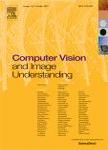版权所有:内蒙古大学图书馆 技术提供:维普资讯• 智图
内蒙古自治区呼和浩特市赛罕区大学西街235号 邮编: 010021

作者机构:Univ Surrey Ctr Vis Speech & Signal Proc Guildford GU2 7JW Surrey England
出 版 物:《COMPUTER VISION AND IMAGE UNDERSTANDING》 (计算机视觉与图像理解)
年 卷 期:2011年第115卷第4期
页 面:541-558页
核心收录:
学科分类:0808[工学-电气工程] 08[工学] 0812[工学-计算机科学与技术(可授工学、理学学位)]
基 金:EPSRC [EP/E027946] EU EPSRC [EP/E027946/1] Funding Source: UKRI
主 题:Facial expression recognition Multi-view facial expression recognition Head pose estimation Local binary patterns Local gabor binary patterns
摘 要:Research into facial expression recognition has predominantly been applied to face images at frontal view only. Some attempts have been made to produce pose invariant facial expression classifiers. However, most of these attempts have only considered yaw variations of up to 45 degrees, where all of the face is visible. Little work has been carried out to investigate the intrinsic potential of different poses for facial expression recognition. This is largely due to the databases available, which typically capture frontal view face images only. Recent databases, BU3DFE and multi-pie, allows empirical investigation of facial expression recognition for different viewing angles. A sequential 2 stage approach is taken for pose classification and view dependent facial expression classification to investigate the effects of yaw variations from frontal to profile views. Local binary patterns (LBPs) and variations of LBPs as texture descriptors are investigated. Such features allow investigation of the influence of orientation and multi-resolution analysis for multi-view facial expression recognition. The influence of pose on different facial expressions is investigated. Others factors are investigated including resolution and construction of global and local feature vectors. An appearance based approach is adopted by dividing images into sub-blocks coarsely aligned over the face. Feature vectors contain concatenated feature histograms built from each sub-block. Multi-class support vector machines are adopted to learn pose and pose dependent facial expression classifiers. (C) 2010 Elsevier Inc. All rights reserved.